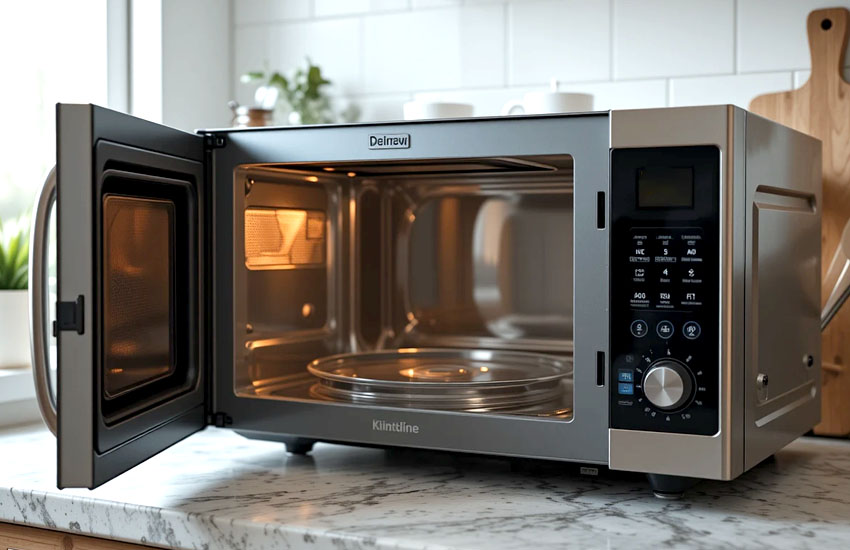Have you ever wondered what happens if you put an empty mug or bowl in the microwave and hit “start”? It’s a question that might sound a little silly at first, but when you think about it, there’s actually a lot going on behind the scenes. Does it do anything? Is it safe? Can you break your microwave by microwaving nothing at all? Let’s dive into the fascinating world of microwaving nothing and uncover what really happens when you hit that button with an empty microwave. This might just surprise you more than you think!

The Basics: What Happens When You Microwave Nothing?
When you put something in the microwave and hit “start,” the microwave uses electromagnetic waves, specifically microwaves, to heat up food or liquids. These waves get absorbed by the water, fat, and sugar molecules in your food, causing them to vibrate and generate heat. This process works best when there’s something in the microwave to absorb that energy. But what happens if there’s nothing there?
In short, microwaving nothing means there’s no food or liquid to absorb the microwave energy. Instead, the microwave energy just bounces around inside the cavity. Without something to absorb the energy, the waves keep bouncing off the walls of the microwave and essentially “do nothing.” However, that doesn’t mean there are no consequences. There’s more happening than meets the eye.
Why Does It Matter?
Even if there’s no food to heat, microwaves still need to be absorbed by something. Microwaving nothing means that this energy can get reflected back into the microwave’s magnetron, which is the part responsible for generating the microwaves. This can cause some unusual things to happen that might affect the overall performance of your microwave in the long run.
Can It Be Dangerous?
In most cases, microwaving nothing is relatively safe. The microwave will just run as usual, but it won’t heat anything up. The real concern comes from the potential damage to the magnetron if you make this a regular habit. That’s the part we’ll dive into next, because while microwaving an empty space might seem harmless, it can actually be a bit more problematic than you think.
Does the Microwave Heat Up Empty Space?
So, you’re probably wondering—does the microwave actually heat up the air or the empty space inside? The short answer is no. Microwaves work by transferring energy to food or liquid molecules that are capable of absorbing the microwave radiation. Air and other empty spaces don’t absorb this energy in the same way. So, if you microwave nothing, there’s no transfer of energy to heat anything.
However, even though the microwave isn’t heating up anything, the energy doesn’t just disappear. It reflects off the metal walls of the microwave and bounces around inside. This bouncing can affect the performance of the microwave over time, and it’s something you definitely don’t want to do repeatedly.
How Does the Microwave’s Technology Work?
At the heart of every microwave is the magnetron. This is the component that generates the microwaves, which are then directed into the microwave’s cooking cavity. When you place food inside, the microwaves get absorbed by the food, causing the molecules to vibrate and heat up. The process is efficient because the food absorbs the energy and transforms it into heat.
However, when you microwave nothing, there’s nothing to absorb that energy, so the microwaves keep reflecting off the metal walls inside. This constant bouncing around of energy can lead to some issues with the internal components of the microwave, especially if done repeatedly.
What About the Microwave’s Magnetron?
The magnetron, as mentioned, is the component that generates the microwaves. If there’s nothing in the microwave to absorb the energy, that energy gets reflected back towards the magnetron. While microwaves are designed to handle this to some extent, doing this repeatedly can overheat the magnetron and potentially cause it to malfunction. This is why it’s generally not a great idea to microwave nothing too often.
The Impact on Your Microwave’s Components
While microwaving nothing won’t immediately cause your microwave to explode or break, it can certainly have a negative effect on the appliance over time. The microwave’s magnetron is the most vulnerable part in this case. When you microwave food, the microwave energy is absorbed by the food, so the magnetron doesn’t get stressed. But when there’s no food to absorb the energy, that energy gets reflected back to the magnetron, which can cause it to heat up.
Microwaves are designed to handle a certain amount of reflection, but if this happens too frequently, it can lead to overheating and even failure of the magnetron. The result? A microwave that no longer works or works at a reduced capacity.
How Microwaves Are Built to Handle Empty Space
Interestingly, microwave manufacturers are aware that sometimes you may microwave an empty container, or maybe just forget about it. So, they design microwaves with some built-in safety features. The microwave can still run with empty space, but the energy reflects around the cavity instead of being absorbed by food. While this isn’t ideal, it’s not the worst-case scenario either.
That said, regular use of an empty microwave could put strain on the magnetron, causing it to wear out more quickly. The heating elements and internal circuits could also experience long-term damage. The more often this happens, the faster your microwave will degrade, which leads us to our next point—how you could end up with a damaged microwave if you microwave nothing too often.
Is It Worth the Risk?
Even if your microwave doesn’t break immediately, repeatedly microwaving nothing increases the chances of it wearing out faster than it should. So, while it might seem harmless, if you want your microwave to last as long as possible, it’s probably best to avoid this habit.
Can Microwaving Nothing Damage Your Appliance?
The biggest concern when microwaving nothing is the potential damage to your microwave. The magnetron, which generates the microwaves, is the most likely part of the microwave to suffer from regular use without food inside. But what kind of damage are we talking about here?
First off, the magnetron is responsible for emitting microwaves into the cooking chamber. When there’s nothing to absorb them, those waves just bounce around inside, often returning to the magnetron. This can lead to an overworked magnetron that eventually malfunctions or burns out. While microwaves have safety features built in to minimize this risk, constantly microwaving nothing increases the chances of damage over time.
Magnetron Overheating
The most likely scenario is magnetron overheating. Without anything to absorb the microwaves, the energy gets trapped in the microwave’s cavity and is reflected back at the magnetron. As a result, the magnetron could overheat and fail. This is why some experts suggest that, over time, you could find yourself dealing with a microwave that won’t heat properly or stops working altogether.
Long-Term Wear and Tear
In addition to the magnetron, the internal circuits and heating elements of the microwave can also suffer from this repeated behavior. Microwaves are designed to handle a certain amount of heat and wear, but constant exposure to energy bouncing around inside the cavity can lead to a higher level of wear than normal. This could shorten the lifespan of your microwave, meaning you may need to replace it sooner than expected.
What Happens to the Energy in a Microwave When It’s Empty?
When you microwave something, the microwave energy is absorbed by the food or liquid, which then heats up. But when the microwave is empty, the energy has nowhere to go. It just bounces around the cooking cavity. This energy can’t be absorbed by the air, and it isn’t converted into heat, so it reflects back onto the magnetron, as we’ve discussed before. But how does this all affect the efficiency of the microwave?
Energy Reflection and Efficiency
In a microwave, energy is supposed to be absorbed and converted into heat. When there’s nothing to absorb it, that energy keeps bouncing around inside the cooking cavity. This energy is, in essence, wasted. It doesn’t go into heating your food, and it’s not efficiently used. So, not only can microwaving nothing potentially damage your appliance, but it’s also an inefficient way to use energy.
Energy Dissipation
Some of the energy might be absorbed by the microwave’s walls, but most of it will just bounce around, creating unnecessary heat in the microwave’s internal components. This excess heat could also put stress on the appliance’s internal systems, making it work harder and less efficiently. So, while it might seem harmless to microwave nothing, it’s ultimately wasting energy and could wear down the appliance more quickly than normal use would.
Fun Facts and Myths About Microwaving Empty Containers
Now that we’ve covered the basics of what happens when you microwave nothing, let’s take a step back and look at some fun facts and common myths related to the topic. You might have heard some wild rumors about microwaving empty containers or microwaving with nothing inside, so let’s debunk a few of those myths!
Myth 1: Microwaving an Empty Container Will Cause an Explosion
Many people have heard the myth that microwaving an empty container, especially a metal one, will cause an explosion. While it’s true that microwaving metal can cause sparks, it won’t lead to a massive explosion. However, microwaving an empty metal container is still dangerous because it can cause sparks and damage your microwave. So, while the “explosion” myth is a bit extreme, it’s still important to avoid using metal containers in the microwave when empty.
Myth 2: The Microwave Will Break if You Microwave Nothing
While microwaving nothing won’t immediately break your microwave, it does cause unnecessary strain on the magnetron and other components, as we discussed earlier. So, while the microwave won’t explode or immediately break down, frequent use of an empty microwave can lead to malfunctions over time.
Fun Fact: You Can Microwave a Wet Sponge!
Here’s a fun fact: you can microwave a wet sponge to sanitize it! Simply dampen the sponge, place it in the microwave for about one minute, and the heat will kill most germs and bacteria. Just make sure you don’t microwave it without any water or you could risk damaging your microwave.
I hope this deep dive into the question of what happens when you microwave nothing has cleared up some of the mysteries for you! While it may not be an immediate disaster, microwaving nothing can lead to inefficiency and potential long-term damage to your microwave. So, next time you’re tempted to press start with an empty microwave, think twice!
Frequently Asked Questions
Is it safe to microwave an empty mug?
No, it’s not recommended to microwave an empty mug. The energy from the microwave could reflect off the mug and damage your microwave.
Can microwaving an empty microwave damage the appliance?
Yes, frequently microwaving an empty microwave could cause damage, particularly to the magnetron, which could eventually break.
Do I need to worry if I microwave an empty bowl once in a while?
Occasionally microwaving an empty bowl isn’t a huge problem, but doing it frequently can lead to unnecessary wear on your microwave.
Is it bad to microwave nothing for a short time?
A short time won’t cause immediate damage, but even brief periods of microwaving nothing can contribute to long-term wear.
Can you microwave nothing in a metal container?
No, microwaving an empty metal container can cause sparks and potentially damage your microwave, so avoid it.
Is it safe to microwave nothing if it’s in a plastic container?
Microwaving an empty plastic container is generally safer than metal, but it’s still not recommended to do so regularly.
Do I need to clean my microwave after microwaving nothing?
There’s no need for extra cleaning, but if you notice any buildup or strange smells, it might be worth cleaning the interior of your microwave.
Can microwaving nothing cause a fire?
While it’s unlikely to cause a fire, consistently microwaving nothing could lead to overheating, which could potentially increase the risk of a malfunction or fire.



